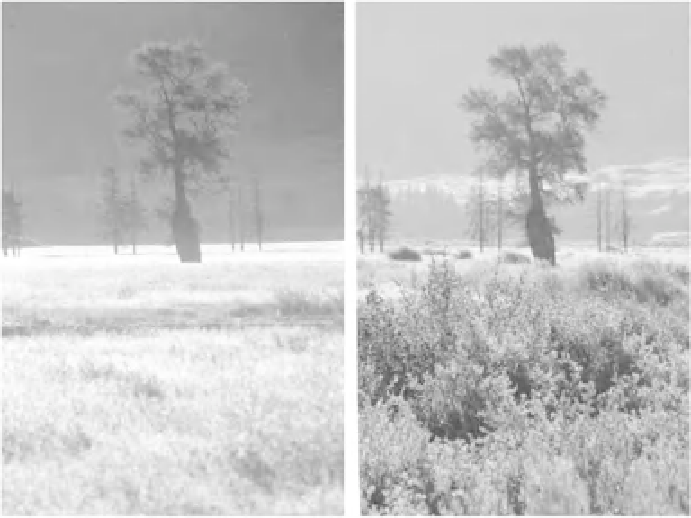Environmental Engineering Reference
In-Depth Information
Figure 8.6
Willow along Soda Butte Creek in summer 1997 (left) and summer 2001 (right). Following a 70-year period of
wolf extirpation, heavy browsing of willows is evident in the 1997 photograph. In 2001, after 6 years of wolf recovery,
willows show evidence of release from browsing pressure (increases in density and height). (Photographs: left, Yellowstone
National Park; right, William J. Ripple.)
wetlands
, loss of riparian beaver and loss of food web
support for aquatic and avian fauna (Ripple & Beschta
2004). When the wolves returned, these effects were
reversed: pressure by elk declined, the browse plants
came back and, with them, the beaver and many other
lost taxa (Figure 8.6). As shown by Ripple and Beschta
(2004), the reason was a change in perceived risk by
the elk in these landscapes associated with various
terrain features (and their fear-related factors). This
example demonstrates the large effect that predation
can have on the spatial distribution of prey, with
various ripple effects on ecosystem structure, content
and development. At present, several other studies
are being carried out in areas where large predators
or raptors have returned or increased, and in these
studies as well large impacts have been found on
prey behaviour and even migration patterns (Jonker
et al
. 2010 ).
Both the Great Lakes and the Yellowstone wolf
examples described above demonstrate that humans
play a crucial role in determining the success or failure
of reintroduction programmes. In the Great Lakes
area, human activities have made complete restoration
of the system unlikely, while in Yellowstone National
Park, after long and intense debate, reintroductions of
the top predator have paved the way for a highly suc-
cessful ecosystem restoration programme.
8.7 SOCIETAL ASPECTS AND
CONCERNS
Reintroductions are generally long-term projects that
require the commitment of long-term fi nancial and
political support. It is important that socio-economic
studies be made to assess the impacts, costs and bene-
fi ts of the reintroduction programme on, for and to
local people. According to the above-cited IUCN (1998)
guidelines, a thorough assessment of attitudes of local
people to any proposed reintroduction project is neces-
sary to ensure long-term protection of the reintro-
duced population, especially if the cause of a species'
decline was anthropogenic (e.g. over-hunting, over-
collection or loss or alteration of habitat due to human
activities). The relevance of these guidelines should not
be underrated because there are many examples of






